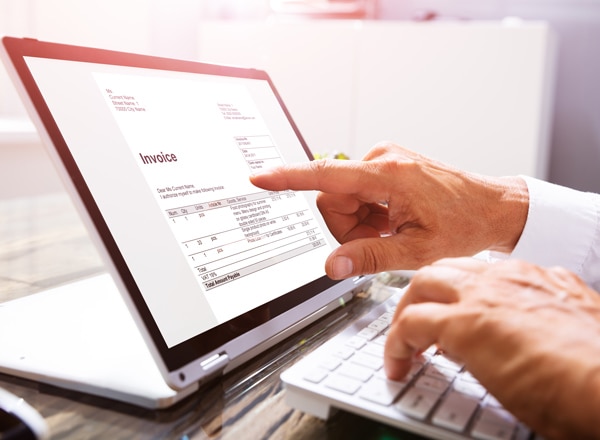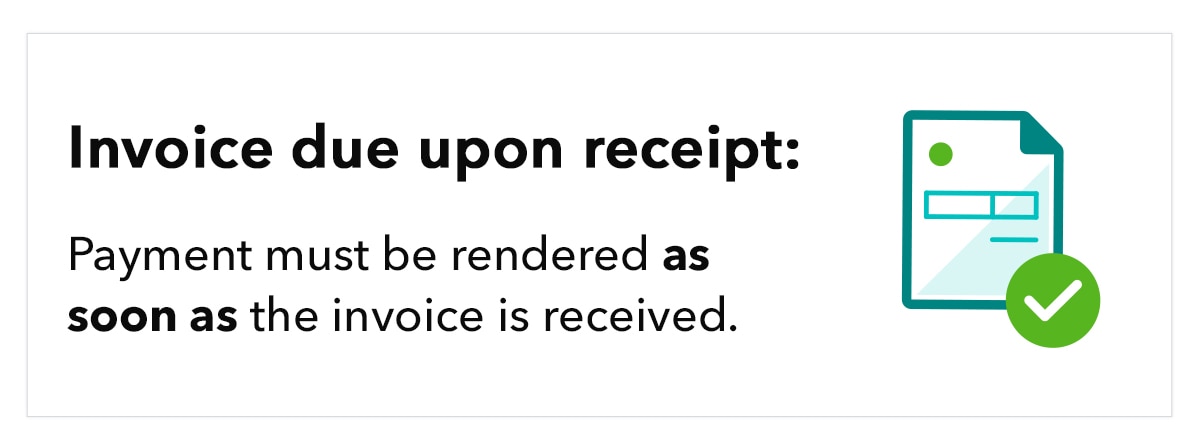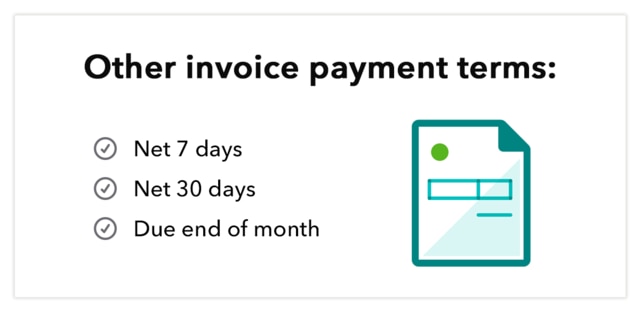

You’ve done the work or delivered the products, and now you want the money you’re owed.
But, unfortunately, late payment (or even worse, non-payment) is a common struggle for business owners. Too often, clients take days or even weeks to pay an invoice, which puts you in a tight spot if you’re counting on that money to keep your business running.
One way to prevent that lag time is to use a “due upon receipt” invoicing method. By requiring payment when the invoice is received, you increase your chances of getting paid immediately while avoiding needing to chase down outstanding payments.
Are invoices due upon the receipt the right choice for you, your customers, and your business? Here’s what you need to know.
A due upon receipt invoice requires that payment be issued as soon as the invoice is received. When your customer receives an invoice from you, they should get you your money as soon as possible. In most cases, payment due upon receipt means paying by the next business day at the latest.

This invoice payment term communicates to your clients that you expect to be paid as soon as your goods or services are delivered, and it’s the next-best option to getting paid upfront.
Our own survey found that the average business owner has $78,355 in outstanding receivables . That’s a lot of missing money for a business with limited cash on hand.
The good news is that, as a business owner, you have the power to set the payment terms and conditions that will benefit your business. For many entrepreneurs, having invoices due upon receipt is an effective way to not only get their money, but also some added peace of mind.
Due upon receipt invoicing is typically the best fit for new clients or one-time clients who need one-off goods or products. That way, you can wrap things up as quickly as possible in one clean transaction.
When this invoicing method gets you your money as soon as possible, why shouldn’t you use it across the board? Particularly with long-standing or recurring clients, this expectation can make you seem demanding and cause friction—especially if your customers need to manage their own cash flow.
There’s no rule that you need to use the same invoicing method across your customers. You might want to consider other ways to invoice, depending on your relationship with different types of customers . It’s not always one-size-fits-all.
When considering which payment terms are the right fit, there’s nothing like a good, old fashioned pros and cons list to provide some clarity. Let’s start with the good news. Due upon receipt invoicing leads to:
The advantages are undeniable, but that doesn’t mean there isn’t a flipside to consider. Particularly in the eyes of your clients and customers, there are a few disadvantages to due upon receipt invoicing. These include:
You’ve decided that you want to use due upon receipt invoicing in your business, but now you’ve reached another hurdle: breaking the news to your clients and customers.
It can be awkward to tell them that you want your money, and you want it now. The key is to use polite but direct language that clearly spells out your payment due date and how they can conveniently issue payment.
Remember, an invoice requiring immediate payment shouldn’t come as a surprise. Your clients should be looped in on the fact that payment is due upon receipt when your initial contract is completed.
Due upon receipt invoicing can be appealing, but it isn’t the only way to go. You could also use the following payment terms:

You can set your invoice payment terms to any number of days you’d like using “Net D” (“D” stands for “days”) payment terms. Maybe you and your client agree that 14 days is a reasonable amount of time to expect payment. You’d then list “Net 14 days” as your invoice payment term.
If you aren’t comfortable with requiring immediate payment but still want to get your money, you can incentivize early payment. For example, you could offer 2% off the total owed if the customer provides immediate payment—even if it isn’t technically due for two weeks.
Regardless of which route you go, make sure that the payment terms and payment due date are listed on your invoice and clearly communicated to your client. It avoids any confusion and helps you contest any payment disputes that might come up.
Looking for more invoicing tips to streamline this aspect of your business and get what you’re owed sooner rather than later? Here’s how to make this a breeze for both you and your customers:
Making your expectations clear doesn’t make you demanding or difficult—it makes you organized and diligent.
When you’ve done what was expected, the last thing you want to do is wait weeks for the money you’re owed—or even worse, never see it hit your bank account.
Due upon receipt invoicing is one way to instill a sense or urgency and encourage your customers to pay right away.
But, much like everything else in your business, it’s not a fit for everyone. Carefully consider the pros and cons and you’ll land on the payment terms that keep you, your clients, and your bank account happy.
We provide third-party links as a convenience and for informational purposes only. Intuit does not endorse or approve these products and services, or the opinions of these corporations or organizations or individuals. Intuit accepts no responsibility for the accuracy, legality, or content on these sites.
**Product information
QuickBooks Live Assisted Bookkeeping: This is a monthly subscription service offering ongoing guidance on how to manage your books that you maintain full ownership and control. When you request a session with a Live Bookkeeper, they can provide guidance on topics including: bookkeeping automation, categorization, financial reports and dashboards, reconciliation, and workflow creation and management. They can also answer specific questions related to your books and your business. Some basic bookkeeping services may not be included and will be determined by your Live Bookkeeper. The Live Bookkeeper will provide help based on the information you provide.
QuickBooks Live Full-Service Bookkeeping: This is a combination service that includes QuickBooks Live Cleanup and QuickBooks Live Monthly Bookkeeping.
1. QuickBooks Online Advanced supports the upload of 1000 transaction lines for invoices at one time. 37% faster based off of internal tests comparing QuickBooks Online regular invoice workflow with QuickBooks Online Advanced multiple invoice workflow.
2. Access to Priority Circle and its benefits are available only to customers located in the 50 United States, including DC, who have an active, paid subscription to QuickBooks Desktop Enterprise or QuickBooks Online Advanced. Eligibility criteria may apply to certain products. When customers no longer have an active, paid subscription, they will not be eligible to receive benefits. Phone and messaging premium support is available 24/7. Support hours exclude occasional downtime due to system and server maintenance, company events, observed U.S. holidays and events beyond our control. Intuit reserves the right to change these hours without notice. Terms, conditions, pricing, service, support options, and support team members are subject to change without notice.
3. For hours of support and how to contact support, click here.
4. With our Tax Penalty Protection: If you receive a tax notice and send it to us within 15-days of the tax notice we will cover the payroll tax penalty, up to $25,000. Additional conditions and restrictions apply. See more information about the guarantee here: https://payroll.intuit.com/disclosure/.
Terms, conditions, pricing, special features, and service and support options subject to change without notice.
QuickBooks Payments: QuickBooks Payments account subject to eligibility criteria, credit, and application approval. Subscription to QuickBooks Online required. Money movement services are provided by Intuit Payments Inc., licensed as a Money Transmitter by the New York State Department of Financial Services. For more information about Intuit Payments' money transmission licenses, please visit https://www.intuit.com/legal/licenses/payment-licenses/.
QuickBooks Money: QuickBooks Money is a standalone Intuit offering that includes QuickBooks Payments and QuickBooks Checking. Intuit accounts are subject to eligibility criteria, credit, and application approval. Banking services provided by and the QuickBooks Visa® Debit Card is issued by Green Dot Bank, Member FDIC, pursuant to license from Visa U.S.A., Inc. Visa is a registered trademark of Visa International Service Association. QuickBooks Money Deposit Account Agreement applies. Banking services and debit card opening are subject to identity verification and approval by Green Dot Bank. Money movement services are provided by Intuit Payments Inc., licensed as a Money Transmitter by the New York State Department of Financial Services.
QuickBooks Commerce Integration: QuickBooks Online and QuickBooks Commerce sold separately. Integration available.
QuickBooks Live Bookkeeping Guided Setup: The QuickBooks Live Bookkeeping Guided Setup is a one-time virtual session with a QuickBooks expert. It’s available to new QuickBooks Online monthly subscribers who are within the first 30 days of their subscription. The QuickBooks Live Bookkeeping Guided Setup service includes: providing the customer with instructions on how to set up chart of accounts; customized invoices and setup reminders; connecting bank accounts and credit cards. The QuickBooks Live Bookkeeping Guided Setup is not available for QuickBooks trial and QuickBooks Self Employed offerings, and does not include desktop migration, Payroll setup or services. Your expert will only guide the process of setting up a QuickBooks Online account. Terms, conditions, pricing, special features, and service and support options subject to change without notice.